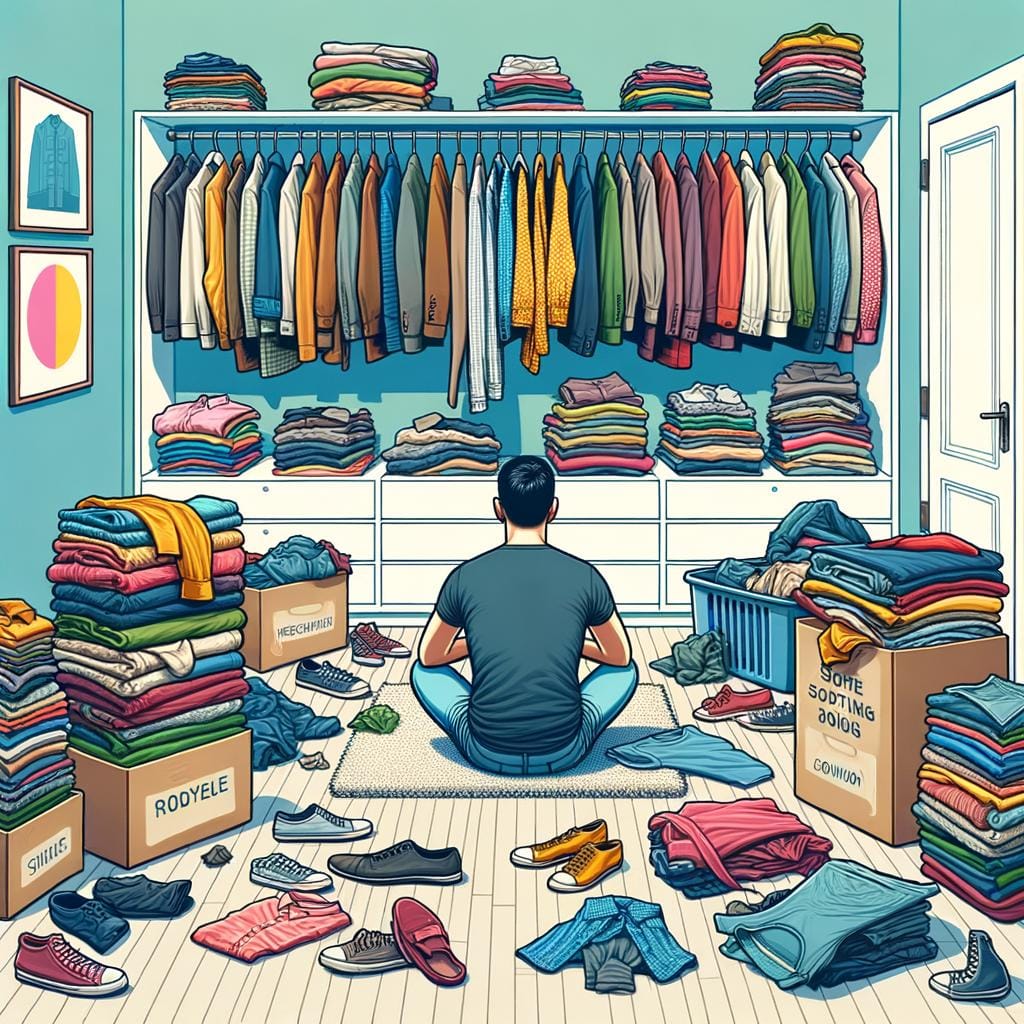Reducing clothing possessions is a growing trend as people seek to simplify their lives and adopt more sustainable habits. The impact of excess clothing possessions goes beyond just clutter in our closets; it also has implications for the environment and our overall well-being. As we accumulate more clothes than we need, we not only take up valuable space in our homes but also contribute to the environmental issues surrounding fast fashion and textile waste.
By decluttering and reducing our clothing possessions, we can experience a range of benefits. Not only will we have less clutter and more space in our closets, but we will also be taking a step towards reducing our carbon footprint.
Assessing your current wardrobe is the first step in this process, helping you identify what you truly need and what items you can live without. This mindful approach to curating your closet can lead to a more intentional and functional collection of clothes that reflect your style and values.
Sorting through your clothes, decluttering, and organizing your closet are essential steps in streamlining your wardrobe. From there, finding sustainable ways to get rid of clothing such as donating, upcycling, or selling can help ensure that your unwanted pieces find new homes instead of contributing to the growing textile waste problem. By embracing a simpler approach to clothing possessions, not only do you free up physical space in your life but also mental space for more important things.
Benefits of Reducing Clothing Possessions
Reducing clothing possessions can have a significant impact on one’s life, both physically and mentally. One of the primary benefits of minimizing your wardrobe is less clutter in your living space.
A cluttered environment can lead to feelings of stress and overwhelm, while a more organized and streamlined closet can bring a sense of calm and order to your daily routine. With fewer clothes to sift through, you can save time getting ready in the morning and focus on what truly matters.
In addition to reducing clutter, minimizing your clothing possessions also means more space in your home. By decluttering your closet and getting rid of items you no longer wear or need, you free up valuable storage space for things that actually serve a purpose in your life. This extra space can make your living areas feel more open and spacious, creating a relaxing environment where you can unwind after a long day.
Furthermore, reducing clothing possessions has a positive environmental impact. The fashion industry is one of the most polluting industries globally, with vast amounts of water, energy, and resources used to produce new garments each year.
By consuming less and making mindful choices about what you buy and keep in your wardrobe, you can help reduce the demand for fast fashion and minimize waste. Embracing a simpler approach to clothing possessions not only benefits you personally but also contributes to a more sustainable future for our planet.
| Benefit | Impact |
|---|---|
| Less Clutter | Reduces stress and brings calmness |
| More Space | Creates open and spacious living areas |
| Environmental Impact | Contributes to sustainability by reducing waste and resource consumption |
Assessing Your Current Wardrobe
One effective way to assess your current wardrobe is by categorizing your clothing items. Separate them into different piles based on their function, style, and frequency of use. This will give you a clear picture of what you own and help in determining which pieces are essential, versatile, or simply redundant. Additionally, consider factors such as seasonality and personal style preferences when evaluating each item.
Creating a detailed inventory or visual representation of your wardrobe can also be helpful in assessing your current clothing possessions. By documenting all your clothing items, you can easily identify duplicates, items that no longer fit or serve a purpose, as well as gaps in your wardrobe that need to be filled. This exercise can guide you in making informed decisions when decluttering and downsizing your collection, leading to a more intentional and curated closet.
| Category | Benefits |
|---|---|
| Categorizing Items | Helps in identifying essentials vs. redundancies |
| Inventory Creation | Allows for visual representation and easy evaluation of possessions |
| Evaluating Functionality | Guides in identifying gaps and excess in the wardrobe |
Sorting and Decluttering
When it comes to reducing clothing possessions, sorting and decluttering your closet is a crucial step in the process. With an overwhelming amount of clothes, it can be challenging to navigate through your wardrobe efficiently and make use of all the items you own. By organizing and streamlining your closet, you not only create a more functional space but also gain a better understanding of what you have and what you may need.
To effectively sort and declutter your clothing collection, consider following these tips:
- Start by taking everything out of your closet and assessing each item individually. This will help you determine which pieces you truly love and wear regularly.
- Create separate piles for clothes to keep, donate/sell, or recycle. Be honest with yourself about the items that no longer serve a purpose in your wardrobe.
- Organize your clothes by category (e.g. tops, bottoms, dresses) or color to make it easier to see what you own and avoid purchasing duplicates.
By implementing these strategies, you can effectively declutter your closet and reduce the number of clothing possessions that are not adding value to your wardrobe. It’s essential to approach this process with a critical eye and let go of items that no longer serve you or align with your personal style. Remember that less is often more when it comes to curating a wardrobe that reflects who you are and fits seamlessly into your lifestyle.
Sustainable Ways to Get Rid of Clothing
When it comes to reducing clothing possessions, one of the key steps is finding sustainable ways to get rid of items that no longer serve you. Whether your closet is overflowing or you simply want to streamline your wardrobe, donating, upcycling, or selling your clothes can be both environmentally friendly and socially responsible.
Donation
One of the most common and impactful ways to part with clothing you no longer need is by donating them to charitable organizations or thrift stores. Not only does this help declutter your own space, but it also gives someone in need access to affordable clothing options. Before donating, make sure to wash and fold items neatly to ensure they can be easily distributed.
Upcycling
For those who are creatively inclined, upcycling old clothing into new garments or household items can be a fun and sustainable way to repurpose items that may otherwise end up in a landfill. With a little creativity and some basic sewing skills, you can transform old shirts into reusable shopping bags, turn worn-out jeans into stylish patches, or even create unique accessories from scraps of fabric.
Selling
If you have gently used or designer pieces that no longer fit your style, consider selling them through online platforms or consignment shops. Not only does this give your clothes a second life with someone who will appreciate them, but it also allows you to recoup some of the initial cost.
Just remember to accurately describe and photograph each item for sale to attract potential buyers effectively. By choosing sustainable methods of reducing clothing possessions like donation, upcycling, or selling, you not only help minimize waste but also contribute positively towards creating a more circular fashion economy.
Building a Capsule Wardrobe
When it comes to reducing clothing possessions, one effective way to streamline your wardrobe is by building a capsule wardrobe. A capsule wardrobe consists of a curated collection of essential and versatile pieces that can be mixed and matched to create various outfits for different occasions. This approach not only helps you declutter your closet but also makes getting dressed easier and more efficient.
To create a successful capsule wardrobe, start by assessing your current wardrobe and identifying key pieces that you wear frequently and enjoy. Consider the colors, styles, and silhouettes that work best for you, as well as the activities you typically engage in. Once you have a good sense of your personal style preferences and lifestyle needs, you can begin building your capsule collection.
Here are some tips for creating a versatile and functional capsule wardrobe:
- Choose quality over quantity: Invest in well-made pieces that will stand the test of time.
- Stick to a cohesive color palette: Select colors that complement each other to easily mix and match outfits.
- Focus on versatile basics: Include staple items like white tees, black pants, denim jeans, and classic blazers that can be paired with multiple pieces.
By following these guidelines and carefully curating your clothing collection, you can build a capsule wardrobe that reflects your personal style, simplifies your daily outfit choices, and helps in reducing clothing possessions overall.
Maintenance Tips for a Minimalist Wardrobe
Maintaining a minimalist wardrobe is crucial to ensure that you continue to reap the benefits of reducing clothing possessions. By keeping your closet in check, you not only save time and effort when getting dressed but also prevent accumulating unnecessary items over time. Here are some maintenance tips to help you stay on track with your minimalist wardrobe:
Regularly Assess Your Wardrobe
One key aspect of maintaining a minimalist wardrobe is regularly reassessing the items you own. Set aside time every few months to go through your clothes and accessories, determining if there are pieces that no longer serve a purpose or fit into your current style. Keeping a critical eye on what you have can help prevent clutter from building up again.
Follow One In, One Out Rule
To avoid undoing all the hard work you put into reducing your clothing possessions, consider implementing the “one in, one out” rule. Every time you purchase a new item, whether it be a replacement for a worn-out piece or a trendy addition, make it a habit to remove an existing item from your wardrobe. This practice ensures that your collection remains curated and prevents overcrowding in your closet.
Organize Efficiently
Proper organization is key to maintaining a minimalist wardrobe. Utilize storage solutions such as color-coded hangers, compartmentalized drawers, or clear containers to keep your clothes neatly arranged and easily accessible. Regularly decluttering and reorganizing your closet can help you appreciate the items you have and prevent any hidden gems from being forgotten at the back of shelves.
By following these maintenance tips for a minimalist wardrobe, you can continue on the path toward simplifying your life and reducing clothing possessions while enjoying a curated collection that reflects your personal style and values. Remember that embracing a more intentional approach to fashion not only benefits you but also contributes to overall sustainability in the long run.
Mindful Shopping Habits
When it comes to reducing clothing possessions, a crucial aspect to consider is our shopping habits. Mindless impulse buys and constantly following trends can lead to unnecessary accumulation of clothes that we may not even wear. By adopting mindful shopping habits, we can avoid falling into the trap of buying items on a whim and instead make smarter choices for our wardrobe.
One important tip is to pause and think before making a purchase. Ask yourself if you truly need the item or if it simply caught your eye because of a passing trend. Consider the versatility of the piece and how it will fit into your existing wardrobe. By taking a moment to reflect on your purchase, you can prevent adding more clutter to your closet and ensure that every new addition serves a purpose.
Another helpful practice is to create a shopping list based on your actual needs. Before heading out to shop or browsing online, take stock of what you already have in your closet and identify any gaps that need to be filled.
This targeted approach can help you focus on acquiring pieces that complement your existing wardrobe rather than adding redundant items. Additionally, setting a budget for clothing purchases can also prevent impulse buys and encourage more deliberate decision-making when it comes to expanding your collection.
Conclusion
In conclusion, embracing a simpler and more sustainable approach to clothing possessions can have a significant impact on both our personal well-being and the environment. By reducing clothing possessions, individuals can experience less clutter, more space in their homes, and contribute to a reduction in textile waste.
This shift towards a minimalist wardrobe not only promotes mindfulness in our consumption habits but also allows for a more intentional and curated collection of clothing that reflects our personal style and values.
Assessing your current wardrobe is essential in understanding what you have and what you truly need. By actively sorting and decluttering your closet, you can organize your belongings more effectively, making it easier to create outfits and reducing decision fatigue. Sustainable methods of getting rid of clothing, such as donation, upcycling, or selling, ensure that unwanted items find new homes instead of ending up in landfills.
Building a capsule wardrobe is another great way to streamline your clothing possessions while still maintaining versatility and functionality in your everyday outfits. By carefully selecting timeless pieces that can be mixed and matched, you can create a wardrobe that suits your lifestyle while minimizing excess. Ultimately, by adopting mindful shopping habits and being intentional with our purchases, we can contribute to a more sustainable fashion industry and reduce our overall environmental footprint.
Frequently Asked Questions
What Is the 12 12 12 Rule for Decluttering?
The 12-12-12 rule for decluttering is a simple method to help organize and tidy up spaces. It involves finding 12 items to throw away, 12 items to donate, and 12 items to return to their proper place. This rule helps break down decluttering tasks into smaller, manageable steps.
How Do You Declutter Clothes Quickly?
Decluttering clothes quickly can be achieved by using the “keep, donate, toss” method. Start by sorting through your clothing items one by one and deciding whether to keep, donate, or toss them. Be decisive and avoid overthinking each item to speed up the decluttering process. Additionally, setting a timer or working in short bursts can help maintain focus and momentum.
What Are the Reasons for Decluttering Clothes?
There are several reasons for decluttering clothes. Firstly, decluttering helps create more space and organization in your wardrobe, making it easier to find and access the clothes you actually wear. It also allows you to assess your style preferences and make room for new pieces that align with your current tastes.
Decluttering clothes can also be emotionally freeing, as it lets go of items tied to past memories or emotions that no longer serve you in the present. Ultimately, decluttering clothes promotes a more mindful approach to consumption and helps reduce waste by passing on unused items to others in need.

Hello, I’m April Denton, your go-to expert for all things home decluttering and organization. With over a decade of experience helping individuals transform their living spaces into serene, clutter-free sanctuaries, I am passionate about the life-changing benefits of decluttering. My journey into the world of organization began out of necessity, juggling a busy career and a bustling household. I quickly realized that a well-organized home was the key to a more balanced, stress-free life.





